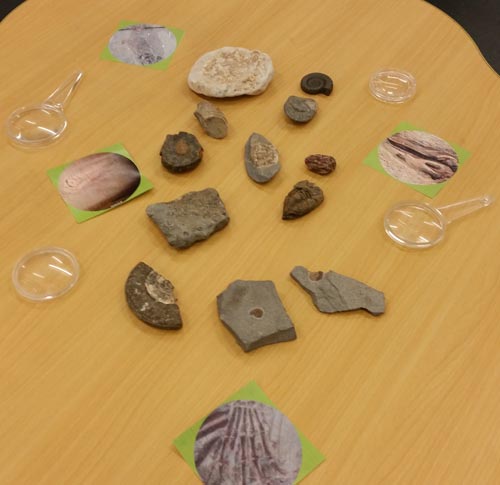Ready to Explore Fossils with Year 2
Whilst on one of our many visits to schools to deliver a workshop to Key Stage 2, we discussed with the teaching team how to add more tactile elements to the school’s scheme of work. We suggested a number of dinosaur and prehistoric animal themed exercises including dedicating a table to create a work station so that fossils could be examined by the children. With some magnifying glasses borrowed from the science cupboard and some scraps of paper on stand-by so that the budding palaeontologists could take notes, it only needed a handful of fossils to complete the fossil study area.
A Fossil Work Station in the Classroom
Picture credit: Everything Dinosaur
Fossils on the Display Table
The fossils consisted of fragments of large ammonites, a complete Promiceras (P. planicosta), some Promicroceras ammonites, along with Arnioceras and Asteroceras pieces, all of which come from Dorset (Jurassic Coast). To this mix of cephalopods, we added crinoids, fossilised seed cones, examples of fossil coral and some pieces representing various trilobites including a large and rather beautiful Calymene trilobite that dates from the Silurian.
For replicas of fossils and models of iconic animals from the fossil record: Fossil Replicas and Dinosaur Teaching Resources.
Being able to handle fossils provides kinaesthetic learners with lots of stimulation, could the children find similar fossils in the text books that they found in library? Could the work out what sort of creature/plant the fossil might represent. Can they describe the fossil? Can they produce an accurate drawing of the object? We even suggested a measuring exercise to help the children gain confidence using rulers.
Happy fossil hunting!
Visit the Everything Dinosaur website: Everything Dinosaur.



Leave A Comment